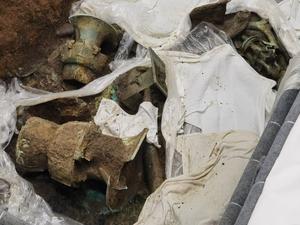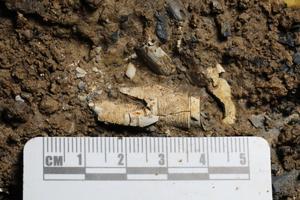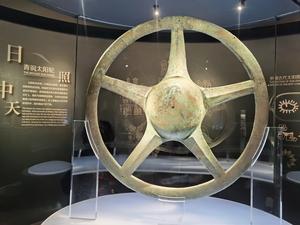Freshly unearthed treasures from famous archaeological site will help answer questions about mysterious ancient culture, Wang Kaihao reports in Guanghan, Sichuan province.
 A newly found 28-centimeter-high gold mask from No 5 pit at the site. (PHOTO PROVIDED TO CHINA DAILY)
A newly found 28-centimeter-high gold mask from No 5 pit at the site. (PHOTO PROVIDED TO CHINA DAILY)
Lei Yu considers himself lucky. Archaeologists dream of having the chance to excavate something like this. In terms of his chosen profession this is the ultimate prize. The stuff dreams are made of.
As the chief archaeologist in charge of the Sanxingdui Ruins site in Guanghan, Sichuan province, dating back more than 3,200 years, Lei thought that the site would have long ago offered up all of its most stunning artifacts. The accidental discovery of two "sacrificial pits"-at least, considered as such by most scholars due to the smashed and burned objects there-in 1986 was incredible.
Back then, more than 1,000 artifacts were recovered from the No 1 and No 2 pits of Sanxingdui, including numerous bronzeware items with exotic markings, as well as figurines, human face masks with protruding pupils and an exquisite 3.95-meter-high "divine tree", believed to have been worshipped as a ladder to heaven.
 New discoveries at the Sanxingdui Ruins site shed light on the ancient Shu civilization, which dates back 3,000 years. Highlighted relics include a variety of bronze items. (PHOTO PROVIDED TO CHINA DAILY)
New discoveries at the Sanxingdui Ruins site shed light on the ancient Shu civilization, which dates back 3,000 years. Highlighted relics include a variety of bronze items. (PHOTO PROVIDED TO CHINA DAILY)
Sanxingdui was found in 1929, and the first scientific excavation was carried out in 1934. It was led by David Crockett Graham, a scholar from the United States. He was also a museum director in Chengdu. But fate, as it so often does, intervened. The decades of upheaval that followed interrupted work on the site. Its significance was not recognized until the bombshell discovery in the 1980s.
"Our archaeological investigations in Sanxingdui have never stopped," says Lei, a researcher from the Sichuan Provincial Cultural Relics and Archaeology Research Institute. "But no one really believed there could be more sacrificial pits."
Ruins of city walls, foundations and tombs have been continuously unearthed within the 12-square-kilometer area of the Sanxingdui site-the biggest prehistoric city ruins on the upper reaches of Yangtze River-which resulted in archaeologists switching their focus to look for a high-level mausoleum.
Sanxingdui, though, had more to offer.
 New discoveries at the Sanxingdui Ruins site shed light on the ancient Shu civilization, which dates back 3,000 years. Highlighted relics include a bronze vessel. (PHOTO PROVIDED TO CHINA DAILY)
New discoveries at the Sanxingdui Ruins site shed light on the ancient Shu civilization, which dates back 3,000 years. Highlighted relics include a bronze vessel. (PHOTO PROVIDED TO CHINA DAILY)
From 2019 to 2020, six more pits (No 3 to No 8)-ranging from 3.5 square meters to 19 square meters-were found near the original pair and, since October, about 500 artifacts have been unearthed in an ongoing detailed excavation.
As soon as the discovery was announced by Lei's team in Chengdu, Sichuan's provincial capital, on Saturday, China's social media was abuzz with public enthusiasm.
"Thanks to a well-planned project, we will have more findings," Lei says. "They're just so important, and people are eager to know what is buried underground, but we have to follow certain steps and take a scientific approach."
Lei's team has already uncovered a long list of possible national treasures and, while the bulk of the current findings have mainly come from pits 3, 4 and 5, the tips of some objects have begun to peek through the dirt in the other three.
A gold mask unearthed from No 5 pit, sporting similar exotic features to those of the previously unearthed bronze face masks, is one of the highlights of the newly-excavated items. Bronze masks and divine trees continue to appear, along with more than 100 ivory tusks. Charred sculptures and jade may add further proof to archaeologists' speculation as to the sacrificial status of the pits.
"The quality of the bronzeware could be even better than the items found in 1986," Lei says.
 New discoveries at the Sanxingdui Ruins site shed light on the ancient Shu civilization, which dates back 3,000 years. Highlighted relics include a bronze divine tree. (PHOTO PROVIDED TO CHINA DAILY)
New discoveries at the Sanxingdui Ruins site shed light on the ancient Shu civilization, which dates back 3,000 years. Highlighted relics include a bronze divine tree. (PHOTO PROVIDED TO CHINA DAILY)
But "new" types of bronzeware raise more questions. For Lei, further study is still required to explain, for example, an animal decoration with an ox's head and a dragonlike body.
A 1.3-meter-high artifact, a kneeling human figurine carrying a vessel over its head, is also a puzzle.
"These mixtures reflect ancient Sanxingdui dwellers' brilliant imagination," Lei says.
On the subject of imagination, it is also expected that, as more cultural relics are unearthed, the ongoing excavation will also finally tether some of the wilder flights of fancy fueled by the discoveries at the site, says Zhao Congcang, a professor at Northwest University in Xi'an, Shaanxi province.
When the exotic and mysterious artifacts were first discovered in 1986, a myriad theories captured the public imagination, but none so compelling as that which claimed extraterrestrial influence on Sanxingdui culture.
"New archaeological findings could guide the public back to a scientific approach to figuring out the origins of Sanxingdui culture," Zhao says. "Cultures are created by people. If we can answer some questions about the people of Sanxingdui, the mysterious parts of their culture may be more easily decoded."
 New discoveries at the Sanxingdui Ruins site shed light on the ancient Shu civilization, which dates back 3,000 years. Highlighted relics include parts of a broken ivory statue. (PHOTO PROVIDED TO CHINA DAILY)
New discoveries at the Sanxingdui Ruins site shed light on the ancient Shu civilization, which dates back 3,000 years. Highlighted relics include parts of a broken ivory statue. (PHOTO PROVIDED TO CHINA DAILY)
A state of curiosity
Who, exactly, were these people?
For researchers, the closest answer may be the ancient state of Shu, which lasted for more than a millennium until its fall to the powerful Qin state during the Warring States Period (475-221 BC). Shu state left many legends but the relevant historical recordings are insufficient.
An academic project was launched to gain a better and more comprehensive understanding of the ancient Shu state (Sichuan is still sometimes colloquially called Shu today). If it were not for that project, the abundance of artifacts in the news today would probably still remain unknown.
Foundations were also recently found nearby, Lei says.
"That helps us to have a basic understanding of the layout of the sacrificial zone," he says. "Our next step is to unveil their ritual system."
A similar strata of objects were uncovered in the newly found pits as the two that were dug in 1986. Small items of bronzeware were at the bottom with larger bronze items above, and the upper surfaces were paved with ivory.
 A 1.3-meter-high bronze mask unearthed from No 2 pit of the Sanxingdui site in 1986. (PHOTO PROVIDED TO CHINA DAILY)
A 1.3-meter-high bronze mask unearthed from No 2 pit of the Sanxingdui site in 1986. (PHOTO PROVIDED TO CHINA DAILY)
Sun Hua, a professor from the School of Archaeology and Museology at Peking University, considers the possibility that deeper study of the pits, their construction style and foundations will offer an insight into the interior of a prehistoric shrine.
"Religious rituals often represent the highest-level ceremonies," Sun says. "We've seen constructional remains of contemporaneous shrines in the rest of world, but they are empty now.
"If we can recover a whole set of ceremonial artifacts used in sacrifices that date back more than 3,000 years (among the unearthed cultural relics in Sanxingdui pits), that'll be an exceptional reference from which to comprehend the religion of the Shu people and their view of the universe," he continues.
New discoveries may connect mythology passed down for generations to more facets of a prosperous civilization through details of the lives of the Shu people.
For example, silk was found in the soil of pit No 4. It resonates with the legend of Cancong, the founding ruler of the ancient Shu state who is said to have been an expert in raising silkworms.
"The lifetime of a silkworm is really short," says Zhou Yang, a researcher with the China Silk Museum in Hangzhou, Zhejiang province. "In the view of ancient Chinese people, it became a unique symbol of life and death.
"Consequently, the earliest silk was not used to make fine clothes, but as a medium through which to connect people with heaven," she says. "So, the finding of silk in a sacrificial place is significant."
She also expects the find, through comparative studies of silk samples unearthed in other regions, to enhance knowledge of a "Silk Road" that is much older than the more widely known ancient trade route.
 Major relics unearthed at the site in 1986 include a bronze sun wheel. (PHOTO PROVIDED TO CHINA DAILY)
Major relics unearthed at the site in 1986 include a bronze sun wheel. (PHOTO PROVIDED TO CHINA DAILY)
Outside influence
Due to the mountainous landscape surrounding Sichuan, in ancient times the region was often considered to be relatively isolated. In a stanza written by the great Tang Dynasty (618-907) poet Li Bai, he describes the road to Shu as "even more difficult than stepping into heaven".
Nevertheless, the findings in the Sanxingdui pits indicate that connection between the region and the outside was commonplace.
In pit No 3, a horde of ritual bronze vessels were recently unearthed. Two square zun, a vessel for holding wine typical to the Shang Dynasty (c. 16th to 11th century BC) which ruled what is today's Central China, were found for the first time. Other bronzeware also carried basic shapes associated with Shang style blended with original designs and details.
"Items from the Sanxingdui culture have outstanding local styles," Zhang Changping, an archaeology professor at Wuhan University in Hubei province, says. "But they also embrace a strong influence from Central China, sharing some cultural identity.
"In Sanxingdui bronzeware we also find some elements of the cultures of the middle and lower reaches of the Yangtze River that have become apparent through a series of separate archaeological excavations along the river," he says.
More artifacts also show the status of Sanxingdui as a cultural crossroads that not only absorbed, but also influenced others across a wide geographic area.
 Major relics unearthed at the site in 1986 include a bronze divine tree. (PHOTO PROVIDED TO CHINA DAILY)
Major relics unearthed at the site in 1986 include a bronze divine tree. (PHOTO PROVIDED TO CHINA DAILY)
An example of this was the discovery of a jade cong, a Neolithic ritual artifact typical to the 5,000-year-old Liangzhu Culture of Zhejiang province nearly 2,000 kilometers away to the east, at the site. An abundant collection of seashells also connects this inland site to the South China Sea.
According to Lei, through archaeological research, influences of Sanxingdui culture have been found to expand to today's Shaanxi province in the north and Yunnan province-and even the northern part of Vietnam-to the south.
"People once had a widely-held view that Central China was the cradle of ancient Chinese civilization, and Sichuan was thought of as a marginal area," says Shi Jinsong, a researcher with the Institute of Archaeology at the China Academy of Social Sciences. "But findings in Sanxingdui unveiled an early-stage regional state, which has changed our view of history.
"With a new perspective of Sanxingdui, we can better see its connection with surrounding civilizations," Shi says. "The unearthed artifacts from the pits cannot be isolated instances. More findings will appear that will hopefully lead to the workshops that produced the artifacts, unveiling a bigger picture of cultural communication."
Some unique phenomena at the site leaves more room to understand its importance from a global perspective.
As no Shang Dynasty bronzeware figurines have been found so far that are forged in the shape of humans, the idolatry practices uncovered in Sanxingdui have aroused speculation about a possible connection to ancient civilizations in West Asia, or even further afield.
"But their specific production method of bronzeware is thoroughly different," Sun, from Peking University, explains. "And compared with those bronze figurines, cast in a more realistic style in the West, the symbolic Sanxingdui figurines are more like a variety of totem poles.
"If we could find constructional components with similar patterns in future excavations in Sanxingdui, we would have a clearer understanding."
 Major relics unearthed at the site in 1986 include a bronze head statue with a gold mask. (PHOTO PROVIDED TO CHINA DAILY)
Major relics unearthed at the site in 1986 include a bronze head statue with a gold mask. (PHOTO PROVIDED TO CHINA DAILY)
With the discovery of a gold scepter, a bronze sun wheel worshipping a sun god-both found in 1986-and gold masks, a connection with the tomb of the contemporaneous Tutankhamen in Egypt was also formed by a curious public.
However, Sun rules out the possibility due to distance and supporting evidence that suggests otherwise, but adds that cross-border comparative studies will better show the importance of the Sanxingdui Ruins during the Bronze Age.
Sanxingdui Ruins has great global significance for archaeology and prehistoric studies, as the artifacts unearthed have revealed a complex society, religion, and civilization, Giuliano Volpe, an Italian archaeologist who, in recent years, has been participating in joint research in Sichuan, told China Radio International.
But for Lei, his biggest hope now is to find written characters in the pits.
After all, as the Sanxingdui site is deeply influenced by the Shang Dynasty, which created the earliest known Chinese written characters via the 3,300-year-old oracle bones, maybe the best way to clear up some of these mysteries is to refer to words.
"We've just started and there are many possibilities," he says. "Thanks to Sanxingdui studies, we'll gradually come to understand how Chinese civilization originated and a mixture of different cultures united."
Contact the writer at wangkaihao@chinadaily.com.cn


